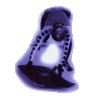|
|
||
|
|
||
 USA Skeleton Sled
USA Skeleton Sled
MCCALLCOLORS is proud to be a new sponsor for Kelly Magnuson of The USA Skeleton Team.
See her custom painted helmet here!
What is a skeleton sled?
Skeleton racing is the oldest
competitive sled racing sport in the world (ancestor to both bobsled and luge).
Skeleton originated in 1892 when an Englishman built a new metal sled, whose
skeletal shape became its namesake. Skeleton was purely recreational until
debuting at the Olympic Winter Games in 1928 in St. Moritz, Switzerland. It
wasn't until 20 years later, in 1948, when St. Moritz again hosted the Games,
that skeleton made the Winter Games program.
Skeleton is a
unique sport in that it uses the same track and start as the bobsled, but
athletes ride down the track headfirst on their sled instead of in a sleigh.
Each skeleton athlete must wear a helmet with a chin guard. This helps prevent
injury, as their faces and chins are only 1 inch from the ice surface when they
race down the track at speeds exceeding 120km/80mph. The goal is to slide down
the track in the fastest time, which means taking the quickest line down the
track and avoiding hitting the walls. To begin, athletes sprint from the start
block. At the 50-meter mark, they jump onto the sled, stomach down, with hands
at their side and toes pointed. Athletes hold their toes only 2 inches from the
ice surface as they slide down the track.
The keys to the skeleton race are the "push" and the competitor's driving technique. Athletes wear shoes with spikes so they can grip the ice at the start and have a fast, hard push. There is no steering mechanism on a skeleton sled, instead racers use their shoulders--and at times their feet-to help guide or steer the sled down the track.
Skeleton sleds may weigh no more than 37 kilograms for women and 43 kilograms for men.
Each skeleton sled
rides on a pair of runners that the athletes polish to increase speed. The
runners are not sharp but are rounded and are about 1 inch in diameter. The
fastest skeleton sleds have the best runners. The skeleton sled and a pair of
runners may cost $5,000 or more.


|
|
|
| Main | Photo Gallery | Site Map |









